Combat Heat Waves with Green Roofs
Historic Heat Waves
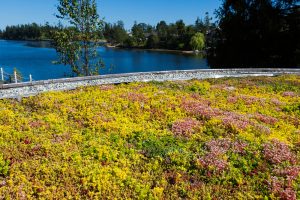
Saanich’s Austin Pump green roof cools the building and retains stormwater.
Communities across British Columbia, Canada experienced a historic heat wave last week. New daily high temperatures were recorded in every region with 60 heat records shattered across the province. West coasters suffered from sweltering heat in their homes.
Extreme heat has been a major health risk and associated with excess mortality in cities across Canada. What changes can communities make to the built environment to combat this? How can our buildings adapt and be more resilient to heat waves in the future?
Adaptation Strategies for Heat Waves
BC Housing’s Mobilizing Building Adaptation and Resilience (MBAR) issued a design discussion primer that provides strategies to address heat waves.

Green roofs can mitigate the Urban Heat Island.
Useful design strategies are provided to prevent overheating and maintain comfort levels. It suggests analyzing the thermal performance of the building and individual units, focusing on windows and walls, solar orientation, shading, natural and cross ventilation. Increase thermal mass performance of the building envelope and allow for night-purging of heat from passive gains.
It recommends using high albedo surfaces and vegetation for cooling. Plant deciduous vegetation along the south, east and west façades and install a vegetated roof to reduce internal heat gains and mitigate the urban heat island effect.
Green Roofs Cool in Many Ways
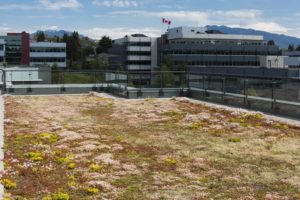
Vancouver’s Broadway Tech Centre is more resilient to heat waves with 10,000 m2 of green roofs.
Evapotranspiration: On a building level, vegetation and growing medium shade and insulate the roof surface. The moisture in the foliage and growing medium coverts from liquid to vapour through evapotranspiration. This cools the roof surface like sweating in humans.
Reduces Energy Demand: The growing medium also adds thermal mass to absorb solar energy during the day and release it back to the atmosphere at night. This modulates the heat flow and dampens diurnal temperature variation, thus reducing the building’s air conditioning demand.
Mitigates Urban Heat Island (UHI) Effect: On a community level, green roofs cover dark heat absorbing roof surfaces with high albedo vegetation that provides evaporative cooling, which are the main strategies that mitigate urban heat island effect. In addition, green roofs also reduce demand for air conditioning and the associated waste heat.
BCIT Green Roof Study
A study by British Columbia Institute of Technology (BCIT) has shown that a typical extensive green roof in Vancouver BC can reduce the heat flow through the roof by 83-85% in spring and summer. It can also reduce the peak roof membrane temperature from 50°C (122°F) to less than 30°C (86°F) and the median temperature fluctuation from 48°C (86°F) to less than 5°C (9°F).
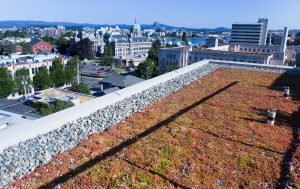
Duet condo’s green roof mitigates the Urban Heat Island effect in Victoria.
Good Heat Relief
As most homes in BC are not equipped with air conditioning, green roofs can reduce solar heat gains and help maintain thermal comfort for occupants. The BCIT study showed that even extensive green roofs offer good heat relief. They are lightweight (60 – 100 kg/m2, 12 – 20psf) and suitable for retrofits and new build.
Designing Resilience for Climate Change
Extreme weather events such as heat waves, rainstorms and hurricanes will only occur more frequently in the future with climate change. CSA A123.26-2021 Performance Requirement for Climate Resilience of Low Slope Membrane Roofing Systems is a new standard that provides increased performance requirements based on climate change projection. Climate-RCI is a web application tool developed by the National Research Council Canada to generate projected performance requirements (temperature, rain and wind) for a particular location in Canada. These tools enable designers to design more resilient buildings by setting higher performance requirements in anticipation of climate change.
Join us for Free, Live Webinars
Green Roof NutsN’Bolts Series: An A-Z of Essential and Practical Tips to Achieve Success
CONTINUING EDUCATION PROVIDER
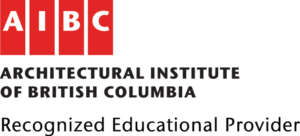
Certificate of Completion will be issued for:
AIBC Core Learning Units
OAA Structured Learning Hours
LACES PDH: CSLA, OALA, BCSLA, AALA, APALA

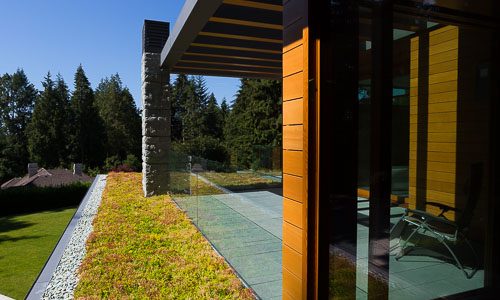
 NLSM has supplied more than 2.5 M SQFT coast to coast
NLSM has supplied more than 2.5 M SQFT coast to coast
Comments are closed.